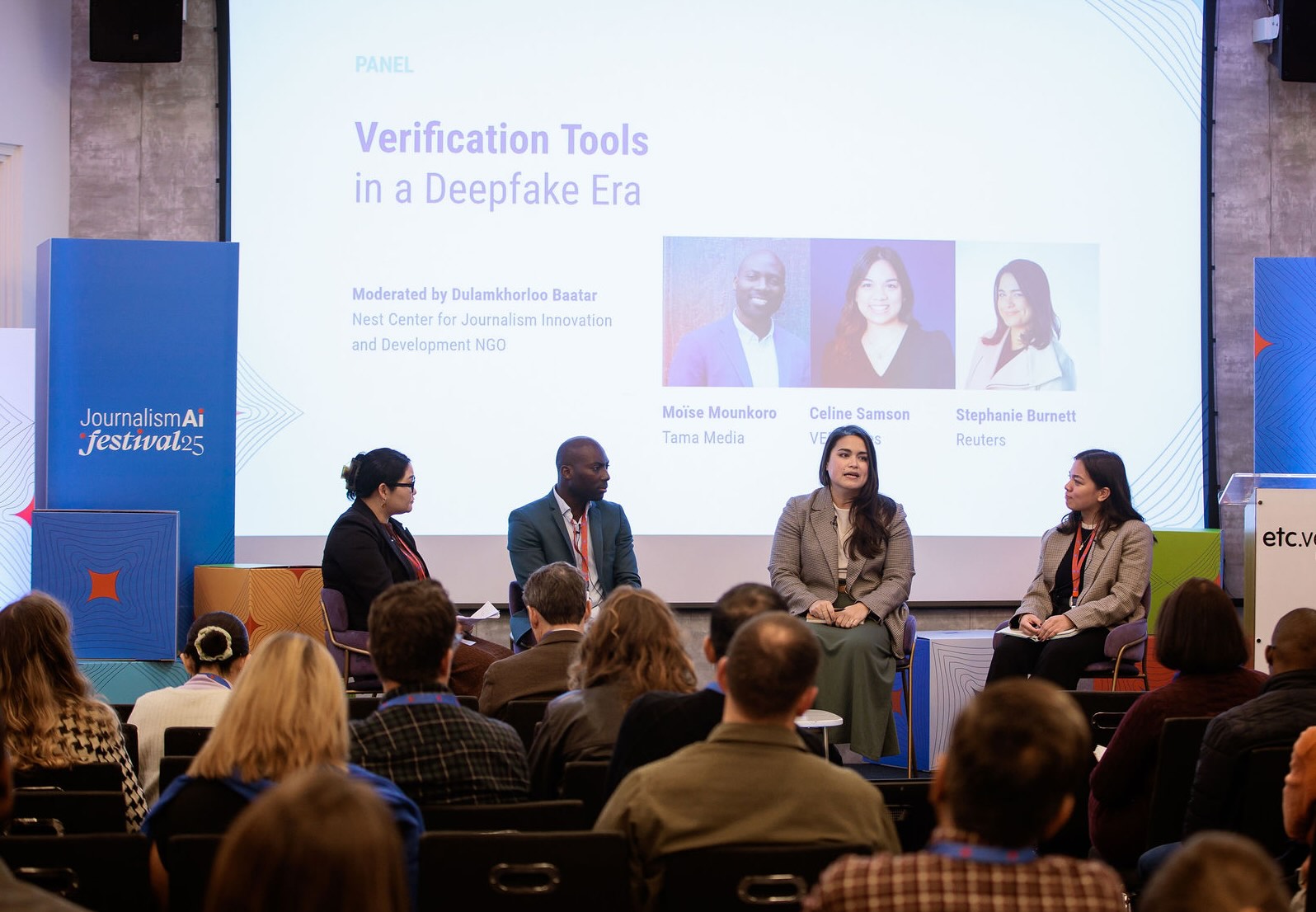JournalismAI Festival 2025: Four projects that caught our eye and a few rising trends

Dulamkhorloo Baatar from the Nest Centre, Moïse Mounkoro from Tama Media, Celine Samson from VERA Files and Stephanie Burnett from Reuters at the Journalism AI Festival, held in London on 11 and 12 November 2025. | Picture courtesy of JournalismAI
A global cohort of journalists, academics and technologists gathered in south London this week to discuss how AI is transforming journalism around the world. The occasion was a festival hosted by JournalismAI, a global initiative created by our friends at journalism think-tank Polis and supported by the Google News Initiative.
Held on Zoom since 2020, the event was held in person for the first time since the start of the COVID-19 pandemic, and featured panel discussions and a series of brief presentations by participants in the JournalismAI Innovation Challenge, a programme to support small and medium-sized news publishers exploring AI uses in their work.
The projects featured at the conference were very different. But one of the key lessons was the importance of focus when building an AI product: identifying a specific, narrow gap to fill, and then following through in order to go from broad experimentation to something useful that endures and brings real value to newsrooms or audiences. Here are four projects that caught our eye, followed by three other trends we found interesting.
1. An AI editor in Europe
The European Correspondent, a Switzerland-based pan-European digital news outlet, often works with freelance correspondents dotted around the continent. In order to be more efficient and provide their writers with valuable feedback, the team developed Vika, an AI-powered companion editor embedded in a CMS.
Automated editing suggestions appear directly alongside the journalist’s draft, checking it for adherence to style and tone, but also comparing the text to the original pitch, and bringing in insight collected from audience members in regular surveys. For example, readers said economics articles tended to use too much jargon, so now journalists writing articles within that beat are prompted to be more explanatory and provide context on difficult concepts.
The goal is to increase the amount of conscious decisions journalists make, said Philippe Kramer, co-founder of the newspaper. It’s also a way to implement their intentional audience strategy: journalists have to identify which readers' needs they intend to fulfil when pitching an article. The AI editor’s role is similar to a first round of editing, with all the writing (and the final editing) still done by human journalists.
2. An AI news presenter in Zimbabwe
Zenzele Ndebele from the Centre for Innovation and Technology CITE, a news and fact-checking organisation from Zimbabwe, explained how his outlet created an AI-generated news presenter called ‘Alice’. This avatar replicates the work that usually takes a team of seven to produce, including camera operators, producers, etcetera.
Ndebele stressed that a human is ultimately responsible for the product and that the AI persona always discloses it’s not human, starting its videos with “My name is Alice and I’m an AI presenter.” However, some men have messaged the organisation trying to ask ‘Alice’ out, he said.
Despite some initial scepticism, some of Alice’s videos have gathered thousands of views. The audience is mostly on board, Ndebele said, but some remain opposed to this use of AI. Our own research suggests that most people are distrusting of AI-generated news presenters, with only 19% of respondents this year saying they feel comfortable with this use of AI.
3. Tracking election promises in the UK
Andy Dudfield from Full Fact, an independent fact-checking organisation in the UK, presented a tool to track the implementation of pledges in political parties’ manifestos.
Working with a team from the University of Cambridge, Full Fact used Gemini to formulate what voters could reasonably interpret the new British government’s election manifesto promises to mean. Then, they used ChatGPT to set up an automated monitoring system to scan trusted sources for evidence of progress relating to one of the pledges.
A summary of these findings is reviewed by a human fact-checker. The result is Government Tracker, a searchable dashboard of promises kept, on track, and broken.
4. Using AI to track prices in Cuba
El Toque, an independent multimedia platform serving Cubans, tracks and publishes real-time exchange rates in Cuba’s complex informal market. The rates are averages of numbers advertised on social media posts and websites, where people buy and sell currency.
This tool is used by many Cuban residents, and is reviled by the Cuban government. Its journalists behind the initiative – including José Jasán Nieves Cárdenas, who was presenting the project at the conference – have received threats.
El Toque uses various AI systems to scrape social media and message boards, extract and clean the data to be found there, interpret slang and typos, and organise the data.
The team used the JournalismAI fellowship to develop El Toque Markets, a subscription-based data platform to provide relevant market data to Cuban business owners, foreign investors and other stakeholders. The initiative will be the first subscription product for a Cuban independent outlet, and might provide the team a way to survive amid widespread donor funding cuts.
Making public information accessible
Several initiatives presented deployed AI to scrape publicly available information, such as from government websites, and display it in a more user-friendly way, or parse it for possible stories:
- One of these was CalMatters, a nonprofit newsroom covering California. The team built a digital democracy tool for the California State Legislature, creating a database of public data and automatically flagging anomalies for potential stories.
- Another example was Brazilian local news outlet Agência Mural, which built a tool to retrieve data about air quality, generate alerts on the website, and send messages via its Whatsapp community
The rise of fact-checking assistants
Several newsrooms built tools to help fact-checkers and make their work more easily accessible to the public:
- Election Watch by the Center for Collaborative Investigative Journalism in Nigeria is an example of this. It’s an AI-powered tool to analyse election misinformation narratives, map actors and visualise timelines, collecting content from social media and categorising it.
- Newtral, a Spanish fact-checking organisation, built something similar: Fact Flow, an AI tool to detect and monitor disinformation specifically on Telegram, saving human fact-checkers from having to manually monitor hundreds of channels.
- Tama Media’s AKILI Check takes the chatbot approach, with an AI-powered assistant to help people in francophone Africa fact-check through text, photo, voice or video in multiple languages, based on content from 50 trusted news sources.
Here come the chatbots
Many of the projects presented at the conference were chatbots aimed at a specific audience. There was VERA Files’ Seek, trained on its coverage of the Philippines; Verified News Network’s Lyle, an indigenous-informed AI for Native Americans in the US; Raseef22’s Aunty chatbot, with the persona of a fictional 57-year-old woman speaking in Egyptian Arabic.
You’ll find many more details about all of these projects in JournalismAI’s newly published report, detailing the work of the 2024 JournalismAI Innovation Challenge participants. The team is now launching a call for applications for the second cohort of the challenge. This year they’ll be supporting up to 12 news organisations with grants of up to $100,000. | Learn more and apply now
In every email we send you'll find original reporting, evidence-based insights, online seminars and readings curated from 100s of sources - all in 5 minutes.
- Twice a week
- More than 20,000 people receive it
- Unsubscribe any time







